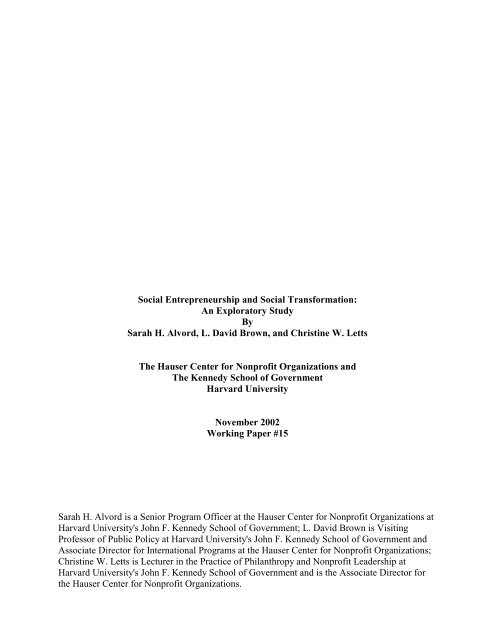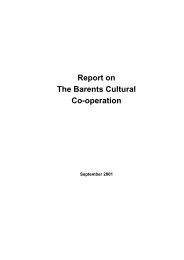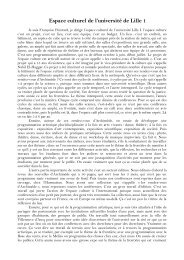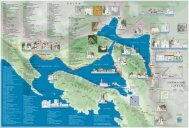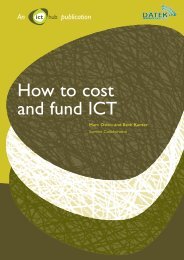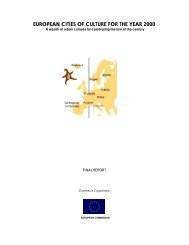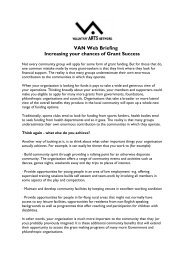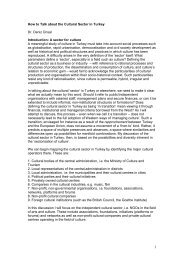Outline for Comparative Analysis Paper - Harvard Kennedy School ...
Outline for Comparative Analysis Paper - Harvard Kennedy School ...
Outline for Comparative Analysis Paper - Harvard Kennedy School ...
You also want an ePaper? Increase the reach of your titles
YUMPU automatically turns print PDFs into web optimized ePapers that Google loves.
Social Entrepreneurship and Social Trans<strong>for</strong>mation:<br />
An Exploratory Study<br />
By<br />
Sarah H. Alvord, L. David Brown, and Christine W. Letts<br />
The Hauser Center <strong>for</strong> Nonprofit Organizations and<br />
The <strong>Kennedy</strong> <strong>School</strong> of Government<br />
<strong>Harvard</strong> University<br />
November 2002<br />
Working <strong>Paper</strong> #15<br />
Sarah H. Alvord is a Senior Program Officer at the Hauser Center <strong>for</strong> Nonprofit Organizations at<br />
<strong>Harvard</strong> University's John F. <strong>Kennedy</strong> <strong>School</strong> of Government; L. David Brown is Visiting<br />
Professor of Public Policy at <strong>Harvard</strong> University's John F. <strong>Kennedy</strong> <strong>School</strong> of Government and<br />
Associate Director <strong>for</strong> International Programs at the Hauser Center <strong>for</strong> Nonprofit Organizations;<br />
Christine W. Letts is Lecturer in the Practice of Philanthropy and Nonprofit Leadership at<br />
<strong>Harvard</strong> University's John F. <strong>Kennedy</strong> <strong>School</strong> of Government and is the Associate Director <strong>for</strong><br />
the Hauser Center <strong>for</strong> Nonprofit Organizations.
Social Entrepreneurship and Social Trans<strong>for</strong>mation:<br />
An Exploratory Study<br />
Abstract<br />
This study provides a comparative analysis of seven cases of social entrepreneurship that have<br />
been widely recognized as successful. The paper suggests factors associated with successful<br />
social entrepreneurship, particularly with social entrepreneurship that leads to significant<br />
changes in the social, political and economic contexts <strong>for</strong> poor and marginalized groups. It<br />
generates hypotheses about core innovations, leadership, organization, and scaling up in<br />
successful social entrepreneurship. The paper concludes with a discussion of the implications <strong>for</strong><br />
the practice of social entrepreneurship, <strong>for</strong> further research, and <strong>for</strong> the continued development<br />
of support technologies and institutions that will encourage future social entrepreneurship.<br />
2
Introduction<br />
The concept of entrepreneurship, long hallowed in the context of business and economic<br />
ventures, has been increasingly applied to the context of social problem solving (e.g., Dees,<br />
1998a; 1998b; Thake & Zadek, 1997; Emerson & Twersky, 1986). The challenges of finding<br />
effective and sustainable solutions to many social problems are substantial, and solutions may<br />
require many of the ingredients associated with successful innovation in business creation.<br />
But solutions to social problems, such as sustainable alleviation of the constellation of health,<br />
education, economic, political and cultural problems associated with long-term poverty, often<br />
demand fundamental trans<strong>for</strong>mations in the political, economic, and social systems that underpin<br />
current stable states. The test of successful business entrepreneurship is the creation of a viable<br />
and growing business, often embodied in the survival and expansion of a business organization.<br />
The test of social entrepreneurship, in contrast, may be a change in the social dynamics and<br />
systems that created and maintained the problem – and the organization created to solve the<br />
problem may get smaller or less viable as it succeeds.<br />
While the concept of social entrepreneurship is relatively new, initiatives that employ<br />
entrepreneurial capacities to solve social problems are not. We have found a variety of<br />
initiatives – particularly focused on the problems of poor and marginalized populations – that<br />
have trans<strong>for</strong>med the lives of thousands of people around the world. The practice of social<br />
entrepreneurship may be well ahead of the theory – as in other areas of social action.<br />
This paper seeks to identify factors associated with successful social entrepreneurship, and<br />
particularly with social entrepreneurship that leads to significant changes in the social, political<br />
and economic contexts <strong>for</strong> poor and marginalized groups; in other words, social entrepreneurship<br />
that leads to social trans<strong>for</strong>mation. We begin with a brief description of different perspectives on<br />
social entrepreneurship and the working definition that has guided our analysis of an in<strong>for</strong>mal<br />
sampling of seven cases. We then describe our methods of inquiry and the issues we used to<br />
focus attention across the seven cases. The next section reports the results of comparisons across<br />
the cases, and <strong>for</strong>mulates hypotheses about core innovations, leadership, organization, and<br />
scaling up in successful social entrepreneurship. The final section discusses implications <strong>for</strong> the<br />
practice of social entrepreneurship, <strong>for</strong> further research, <strong>for</strong> the continued development of<br />
support technologies and institutions <strong>for</strong> future social entrepreneurship.<br />
Background<br />
The concept of entrepreneurship has a long history in the business sector. A major theme has<br />
been the creation of value through innovation. (Schumpeter, 1951; Drucker, 1985). As applied<br />
more recently to social concerns, the concept has taken on a variety of meanings.<br />
Some, <strong>for</strong> example, have focused on social entrepreneurship as combining commercial<br />
enterprises with social impacts. In this perspective, entrepreneurs have used business skills and<br />
knowledge to create enterprises that accomplish social purposes in addition to being<br />
3
commercially viable (Emerson and Twersky, 1996). Not-<strong>for</strong>-profit organizations may create<br />
commercial subsidiaries and use them to generate employment or revenue that serves their social<br />
purposes, or <strong>for</strong>-profit organizations may donate some of their profits or organize their activities<br />
to serve social goals. These initiatives use resources generated from successful commercial<br />
activities to advance and sustain their social activities.<br />
Others have emphasized social entrepreneurship as innovating <strong>for</strong> social impact. In this<br />
perspective, attention is focused on innovations and social arrangements that have consequences<br />
<strong>for</strong> social problems, often with relatively little attention to economic viability by ordinary<br />
business criteria (e.g., Dees, 1998b). Social entrepreneurs are focused on social problems, and<br />
they create innovative initiatives, build new social arrangements, and mobilize resources in<br />
response to those problems rather than the dictates of the market or commercial criteria.<br />
Still others see social entrepreneurship as a way to catalyze social trans<strong>for</strong>mation well beyond<br />
the solutions of the social problems that are the initial focus of concern. From this perspective,<br />
social entrepreneurship at its best produces small changes in the short term that reverberate<br />
through existing systems to catalyze large changes in the longer term (Ashoka Foundation,<br />
2000). Social entrepreneurs in this tradition need to understand not only immediate problems but<br />
also the larger social system and its interdependencies, so that the introduction of new paradigms<br />
at critical leverage points can lead to cascades of mutually-rein<strong>for</strong>cing changes that create and<br />
sustain trans<strong>for</strong>med social arrangements. Sustainable social trans<strong>for</strong>mations include both the<br />
innovations <strong>for</strong> social impacts and the concern <strong>for</strong> ongoing streams of resources that characterize<br />
the other two perspectives on social entrepreneurship – and they also lead to major shifts in the<br />
social context within which the original problem is embedded and sustained.<br />
While we believe that all three approaches to social entrepreneurship have considerable utility,<br />
we are particularly interested in the perspective that emphasizes social entrepreneurship as a<br />
catalyst <strong>for</strong> social trans<strong>for</strong>mation in this study. So, more specifically, this study focuses on social<br />
entrepreneurship that creates innovative solutions to immediate social problems and also<br />
mobilizes ideas, capacities, resources, and social arrangements required <strong>for</strong> long-term,<br />
sustainable, social trans<strong>for</strong>mations.<br />
Be<strong>for</strong>e exploring a broad number of social entrepreneurship cases that vary in location, size, and<br />
focus, we chose a small group of cases to give us some initial data with which we could begin<br />
generating hypotheses. These cases are widely recognized as meeting the above social<br />
entrepreneurship definition – they are all innovative ef<strong>for</strong>ts to solve persistent social problems of<br />
poverty and marginalization that to some extent have been successful in scaling up their impacts<br />
and at least potentially catalyzing social trans<strong>for</strong>mation. In comparing the cases, we have<br />
focused in particular on four aspects of their experience: the nature of the innovations they have<br />
articulated, the characteristics of their leaders, the organization of the initiatives, and the paths<br />
chosen <strong>for</strong> scaling up their impacts.<br />
First, most definitions of social entrepreneurship emphasize the innovative character of the<br />
initiative. In comparing the cases, we will examine the nature of the innovation in some detail.<br />
Not all provision of goods and services amounts to social entrepreneurship, of course. In many<br />
cases, replication or expansion of existing services is a valuable solution to a social problem –<br />
but not one that necessarily requires social entrepreneurship. When the resources or capacities to<br />
duplicate existing services <strong>for</strong> poor and marginalized groups are not available, creative initiatives<br />
that reconfigure existing resources or services <strong>for</strong> more effective or wider delivery are imperative<br />
4
to serve wider populations (e.g., Uphoff, Esman, and Krishna, 1997, 1998). Such creative<br />
initiatives represent social entrepreneurship. We will be interested in the patterns of innovation<br />
that appear across cases: Is there a single pattern <strong>for</strong> success? Are there a variety of <strong>for</strong>ms of<br />
innovation that appear to be associated with different kinds of problems or contexts?<br />
Second, we will look closely at the characteristics of leadership of socially entrepreneurial<br />
ventures. Much of the literature on leadership focuses primarily on individuals and their<br />
personal skills or attributes (e.g. Gardner, 1995; Heifetz, 1994), and certainly in Western<br />
experience, particular individuals have made major contributions to entrepreneurial ventures. On<br />
the other hand, in some contexts, leadership groups may be more important than individuals, and<br />
focusing primarily on individuals may obscure essential aspects of the initiative (Paul, 1982;<br />
Thake & Zadek, 1997). We believe that leadership – whether group or individual -- is important<br />
in the success of social entrepreneurial ventures. What are characteristics of leaders who found<br />
entrepreneurial social ventures? How do they respond to the challenges that emerge over time<br />
and as the initiative grows?<br />
A third set of issues <strong>for</strong> investigation is the organizational and institutional features of social<br />
entrepreneurship. Substantial evidence suggests that as initiatives face the challenges of<br />
expansion of their impact and sustaining their initiatives, their organizational and institutional<br />
features are important factors (Tendlar, 1989; Paul, 1982; Uphoff et. al. 1998). We will examine<br />
the organizational and institutional aspects of successful initiatives to see if we can identify<br />
common patterns. To what extent are there “best practices” that appear across many different<br />
cases? How do initiatives expand their operational capacities or evolve their strategies in the<br />
face of shifting task and environmental challenges?<br />
Finally, we are also interested in the paths by which entrepreneurial ventures expand and sustain<br />
their impacts and trans<strong>for</strong>m larger systems in which they are embedded. Some studies of<br />
expansion of development impacts suggest that routinizing technology (Tendlar, 1989) is critical<br />
to reaching larger constituencies, or that carefully crafting a sequence of gradually expanding<br />
projects and programs are critical to successful scaling up. (Rondinelli, 1983) Others suggest<br />
that a menu of different patterns <strong>for</strong> scaling up impacts can be identified, and that the key issues<br />
in scaling up involve organizing to fit the strategy chosen (Uvin, 1995; Uvin, Jain and Brown,<br />
2000). To what extent are different approaches to scaling up visible across the cases? Are there<br />
patterns of scaling up that are particularly associated with success in catalyzing long-term<br />
changes in social arrangements that shaped and sustained the initial problems?<br />
Methodology<br />
This study provides a comparative analysis of cases of social entrepreneurship that have been<br />
widely recognized as successful. This study seeks to identify patterns and regularities across<br />
successful initiatives. It is a hypothesis-generating rather than a hypothesis-testing approach to a<br />
complex and not yet well-understood topic. <strong>Comparative</strong> analysis of cases can be a useful way<br />
of generating hypotheses about phenomena that combine complex phenomena, long-term<br />
dynamics, and difficulties in access (Yin, 1984). Case descriptions provide the kinds of<br />
in<strong>for</strong>mation that allow recognition and assessment of unexpected patterns that would not be<br />
captured by more constrained methodologies. The cost of such richness and flexibility is the<br />
increased difficulty to make systematic comparisons or to draw unambiguous conclusions.<br />
5
The cases used in this study are drawn from existing literature and descriptions. The decision to<br />
use existing descriptions limits our ability to gain precisely comparable data and also subjects us<br />
to the biases of multiple observers. Since the costs of collecting original data <strong>for</strong> a study that<br />
spans four continents would be very high, we are willing to accept these limitations <strong>for</strong> a<br />
hypothesis-generating study. When similar patterns emerge in diverse cases, we can be more<br />
confident that those patterns are relatively robust. In our analysis of the cases described here, we<br />
will use tables and matrices to enable comparison across cases, a tool used extensively in<br />
multiple case analysis (Yin, 1984; Miles and Huberman, 1994). We will focus particularly on<br />
patterns that seem to characterize many or most of the cases.<br />
We generated in<strong>for</strong>mation about the cases from published and unpublished reports, internet<br />
resources, and interviews with organization members and in<strong>for</strong>med observers. We first used<br />
these data to identify patterns related to our four areas of interest in each case, and then<br />
constructed matrices that allowed us to compare patterns across cases. The results of this process<br />
should be considered as tentative concepts and hypotheses.<br />
The cases were chosen to meet the several criteria.<br />
• They are widely regarded as successful examples of social entrepreneurship on behalf of<br />
poor and marginalized communities.<br />
• They come from diverse regions, including Asia, Africa, Latin America, and North America.<br />
• They have been described in available literature sufficiently to answer our key questions.<br />
• They have exhibited at least some potential <strong>for</strong> catalyzing trans<strong>for</strong>mations in the social<br />
contexts within which they have been implemented.<br />
Table 1 provides a brief overview of the cases and their impacts as background to the analysis in<br />
later sections. More detailed data will be presented in the context of the discussions of particular<br />
concerns in the next section.<br />
Table 1. The Social Entrepreneurship Cases<br />
Bangladesh Rural Advancement Committee (BRAC) was established in 1972 by Fazel Abed, a Bangladeshi<br />
corporate executive, in the aftermath of the Independence War. Over the past 30 years, BRAC has focused on<br />
breaking the cycle of poverty in Bangladesh. Starting as a relief and resettlement organization, BRAC pioneered the<br />
development of comprehensive, locally-organized approaches to rural development and poverty alleviation. It has<br />
provided a range of services– rural capacity-building, education, health services, micro-credit—to 2.6 million rural<br />
people, and it has been exceptionally successful in developing projects that contribute to its own financial<br />
sustainability.<br />
• Essential Innovation: Focus on local constituent needs and capacities through a systemic approach to poverty<br />
alleviation that emphasizes systematic learning at many levels. Rapid scaling up of the organization while<br />
ensuring sustainability<br />
• Scope: Operates in 60,000 of the 86,000 villages in the country, organizing the poor <strong>for</strong> self help and building<br />
local capacities <strong>for</strong> income generation, health, and education. Emphasis on women and oppressed groups may<br />
fundamentally change local attitudes and culture <strong>for</strong> landless poor as well as economic circumstances<br />
The Grameen Bank (GB) was established in 1976 by Muhammed Yunus, a Bangladeshi economic professor, and<br />
his colleagues. Convinced that poor borrowers might be good credit risks, they demonstrated that landless women in<br />
mutually accountable borrower groups achieved very high repayment rates. The Grameen Bank <strong>for</strong>ms small groups<br />
of five people to provide mutual, morally binding group guarantees in lieu of the collateral. Participants have proved<br />
to be reliable borrowers and astute entrepreneurs, raising their status, lessening their dependency on their husbands<br />
and improving their homes and the nutrition of their children. These borrowers developed the social development<br />
guidelines known as the “Sixteen Decisions”, the basis of village group meetings throughout the Grameen system.<br />
Today, over 90 percent of the millions of microcredit borrowers around the world are women.<br />
6
• Essential Innovation: Group lending <strong>for</strong> poor peoples without collateral. Scale up an organization/expand<br />
organizational capacity to serve millions of small borrowers.<br />
• Scope: Provided small loans to 2.3 million very poor borrowers. Created 12 other businesses (e.g. fisheries, hand<br />
loom, renewable energy) to serve the poor. Catalyzed fundamental changes <strong>for</strong> poor women’s role in income<br />
generation as well as changes in micro-credit theory and practice around the world.<br />
The Green Belt Movement (GBM) was established in 1977 to encourage tree planting in Nairobi by Wangari<br />
Maathai and the National Council of Women in Kenya. The Movement organized small groups of poor community<br />
members in both rural and urban settings to grow, plant and care <strong>for</strong> trees in “greenbelts” on public and private land.<br />
The Movement has organized more than 6,000 groups in poor villages and urban areas across the country and has<br />
planted over 20 million trees. Over the last ten years, GBM has adopted a “conscientization” approach to mobilize<br />
community consciousness <strong>for</strong> self-determination, equity, improved livelihood and environmental conservation. It has<br />
helped hundreds of grassroots leaders to advocate <strong>for</strong> social, economic and political justice. Internationally, GBM<br />
has begun to facilitate a Pan African Network to help “green conscious”/social justice groups in other African<br />
countries develop similar approaches to community mobilization.<br />
• Essential Innovation: Grassroots mobilization, conscientization, and leadership development through<br />
environmental activities<br />
• Scope: Facilitated 20 million trees planted in Kenya (70% survival rate). Mobilized 50,000 Kenyan households<br />
to care <strong>for</strong> the environment and improve their own well-being.<br />
The Highlander Research and Education Center (HREC) was founded by Myles Horton in 1932 in a rural<br />
Appalachian mountain community in the Southern United States. The Center is dedicated to eliminating poverty and<br />
promoting genuine democratic participation <strong>for</strong> all people. Highlander provides education and research support to<br />
grassroots individuals and organizations working to address the inequities rooted in the political, cultural, and<br />
economic structures of communities. It began working with the labor movement, played a pivotal role in the Civil<br />
Rights movement, and has worked on other many other struggles in Appalachia and the Deep South. It currently<br />
focuses on economic injustice and democratic participation in the U.S. and internationally.<br />
• Essential Innovation: Use adult education to help grassroots individuals and groups develop their own solutions<br />
to problems of political voice and local problem-solving. Turns over innovative programs to movement and<br />
becomes support organization to it.<br />
• Scope: Developed labor education programs that enabled American labor movements and in turn, international<br />
labor movements, to create political and economic policy changes. Developed leadership <strong>for</strong> civil rights<br />
movement (Southern Christian Leadership Committee and Student NCC): Citizenship <strong>School</strong> model trained<br />
thousands of blacks in literacy skills to gain voting rights and to participate in local communities.<br />
Plan Puebla (PP) was initiated in Mexico in 1966 by a small group of agricultural researchers who recognized that<br />
the needs of small subsistence farmers were not being addressed by Mexican agricultural research. The initiative<br />
sought to improve maize production techniques and transfer this new technology to small subsistence farmers, in the<br />
hope of improving the general welfare of rural farm families. The project gained momentum from support of the<br />
newly established International Maize and Wheat Improvement Center. After 10 years, private funding of the<br />
initiative ended and the Mexican government took over the project. The model has been replicated in Columbia,<br />
Peru, Honduras and other areas in Mexico, and the project has enabled the creation of the Cholollan Regional<br />
Cooperative, a credit union founded by <strong>for</strong>mer Plan Puebla staff in 1993, and, the Center of Rural Development<br />
Studies in Puebla.<br />
• Essential Innovation: Improve crop production through focusing on small, farmer-oriented cooperative and<br />
support activities (not simply rolling out of agricultural technology).<br />
• Scope: Increased maize production of 47,000 Mexican farmers in the Plan Puebla region by 62%. Educated poor,<br />
small farmers about income diversification; and facilitated a 252% increase in family income.<br />
The Self-Employed Women’s Association (SEWA), founded in 1972 by Ela Bhatt, is a trade union of women who<br />
earn their livelihoods in three broad occupational categories that historically have been very difficult to organize:<br />
hawkers and vendors, home-based producers, and manual laborers and service providers. Their initial programs<br />
focused on improving the working conditions of their members through influencing the actions of local police and<br />
policy makers. Later, SEWA provided a variety of services that were otherwise unavailable to their members. With<br />
approximately 315,000 members, SEWA is the first and largest trade union of in<strong>for</strong>mal sector workers. In addition<br />
to it unionizing activities, SEWA has several “sister” institutions including a bank to provide financial resources, an<br />
academy to provide teaching, training and research, and a housing trust that coordinates housing activities <strong>for</strong> its<br />
members. SEWA has become an international <strong>for</strong>ce, working with women’s and labor movements worldwide.<br />
• Essential Innovation: Organize women who are atomized and have little reason to cooperate <strong>for</strong> political change<br />
7
and <strong>for</strong> addressing economic, social, and health issues. Build local leadership capacity to scale up organization<br />
and movement.<br />
• Scope: Organized 315,000 self-employed women as union members. Improved working conditions, access to<br />
health care, credit, savings <strong>for</strong> the more than 90% of India’s female labor <strong>for</strong>ce in the self-employed/unorganized<br />
sector. Influenced the creation of self-employment labor division in Indian government. Influenced ILO to pass<br />
standards <strong>for</strong> home workers (including minimum wage and working conditions). Co-founded international<br />
network to support the work of women in the in<strong>for</strong>mal sector (WIEGO).<br />
Se Servir de la Saison Seche en Savane et au Sahel (Six-S) is an association set up in 1976 by founders from<br />
Burkina Faso and France, Bernard Ledea Ouedraogo and Bernard Lecomte, to promote community development<br />
from a peasant perspective, especially in the dry season when jobs are few and far between. Six-S has organized<br />
networks and councils of villagers in several West African countries. After a village has worked with Six-S to<br />
develop an organization, started a savings program, and built management capacity, they can propose projects to<br />
solve local problems. A council of representatives from the network of villages allocates project resources according<br />
to a few simple rules that reduce the likelihood of misuse of funds. Six-S has negotiated arrangements <strong>for</strong> such<br />
“flexible funding” with a coalition of donors, who have been pleased with the results.<br />
• Essential Innovation: “Flexible Funding” <strong>for</strong> local projects approved by regional networks of village elders.<br />
Building-building to prepare villages <strong>for</strong> using resources effectively. Network-building within regions and<br />
countries to foster more in<strong>for</strong>mation-sharing<br />
• Scope: Involved 2 million people involved village projects across 9 countries in the West African Sahelian<br />
region. Assisted villagers in 1,500 villages to develop self-sustaining income-generating projects. Organize<br />
6,500 village groups to strengthen village infrastructure and capacity <strong>for</strong> project development<br />
Patterns in the Cases<br />
This section examines the patterns identified across the seven cases across the four aspects of<br />
each initiative identified earlier: characteristics of innovations, characteristics of leaders,<br />
organizational arrangements, and scaling up approaches. In the analysis that follows, we provide<br />
tables with brief descriptions of the characteristics of each case on the dimensions that emerged<br />
as important <strong>for</strong> each of these aspects. We briefly discuss the concepts that emerge from this<br />
analysis and <strong>for</strong>mulate initial hypotheses to describe the links between those factors and<br />
initiative success.<br />
Characteristics of Innovations<br />
The innovations described in Table 2 are very diverse. They range from microcredit services<br />
provided by the Grameen Bank, to agricultural and tree-planting support from Plan Puebla and<br />
the Green Belt Movement, to support <strong>for</strong> grassroots social movements from SEWA and<br />
Highlander, to village development initiatives by BRAC and Six-S. It is not immediately obvious<br />
that these innovations have much in common, since they focus on different groups and concern<br />
quite different issues.<br />
8
BRAC<br />
Grameen<br />
Bank<br />
Greenbelt<br />
Movement<br />
Highlander<br />
Center<br />
Plan<br />
Puebla<br />
SEWA<br />
Six-S<br />
Table 2: Innovation Characteristics<br />
Core Innovation Pattern Mobilizing Assets and<br />
Capacities of Poor<br />
Build Local Capacity: Create<br />
village groups that can solve<br />
local problems and provide a<br />
variety of services and supports<br />
<strong>for</strong> village development.<br />
Micro-credit Package:<br />
Provide group-based loans <strong>for</strong><br />
poor and marginalized people<br />
to develop income-generating<br />
activities; follow up with other<br />
development programs.<br />
Build Local Capacity: Use<br />
tree planting and civic<br />
education programs to build<br />
local skills and organization <strong>for</strong><br />
self-help activities.<br />
Build Local Movement: Use<br />
adult education tools to<br />
empower and organize local<br />
unions, civil rights groups, and<br />
others to confront abusive<br />
elites.<br />
Agriculture Package: Develop<br />
and spread improvements in<br />
maize production that enable<br />
subsistence farmers to improve<br />
their family welfare and<br />
increase income.<br />
Build Local Movement:<br />
Mobilize self-employed women<br />
to campaign <strong>for</strong> policies to<br />
support work activities and to<br />
develop services adapted to<br />
their work and overall welfare<br />
needs.<br />
Build Local Capacity: Support<br />
village projects to improve<br />
sustainable local resources,<br />
increase income-generating<br />
activities and build villager<br />
capacities through networking<br />
of village organizations.<br />
High: Shift from relief and<br />
service delivery to building local<br />
organizations and capacities <strong>for</strong><br />
self-help, with particular<br />
attention to women.<br />
High: Focus from the start on<br />
improving the capacity of poor<br />
and marginalized people,<br />
especially women, to participate<br />
in small businesses.<br />
High: Focus on building village<br />
level capacity to act together to<br />
solve problems, such as working<br />
together to remedy de<strong>for</strong>estation.<br />
High: Use participatory adult<br />
education to help marginalized<br />
grassroots actors (e.g. labor, civil<br />
rights) organize and campaign<br />
effectively <strong>for</strong> their rights.<br />
Medium: Emphasize technology<br />
to improve agricultural<br />
productivity of small farmers,<br />
but further improvements<br />
depend on outside experts and<br />
resources.<br />
High: Focus on building<br />
capacities of poor self-employed<br />
women to organize and secure<br />
economic and legal rights <strong>for</strong><br />
themselves.<br />
High: Provide non-financial<br />
resources <strong>for</strong> village groups and<br />
serve as intermediary between<br />
donors and village organizations<br />
that demonstrate initial<br />
effectiveness to secure financial<br />
resources <strong>for</strong> improvement<br />
projects.<br />
Emphasis on Continuous<br />
Learning<br />
High: Embrace commitment to<br />
being a learning organization<br />
very early; systems <strong>for</strong> learning<br />
from experience in place <strong>for</strong><br />
individuals, programs, and the<br />
organization as a whole.<br />
Medium: Systematic<br />
investments in learning of<br />
participants and staff; less clear<br />
investment in <strong>for</strong>mal learning<br />
processes at the organizational<br />
level.<br />
Medium: Substantial<br />
investment in learning by village<br />
groups and some in staff<br />
development; No major<br />
resources or commitment to<br />
organizational learning.<br />
Medium to High: Commitment<br />
to staff and partner learning; less<br />
systematic investment in<br />
organizational learning.<br />
Medium: Staff and participating<br />
farmer commitment to learning<br />
about agriculture, but little<br />
investment in organizational<br />
learning. Government takeover<br />
reduces future learning process.<br />
High: Emphasis on helping<br />
members learn new skills and<br />
political capacities; Long-term<br />
commitment to organizational<br />
learning and growth in a<br />
changing political context.<br />
Medium: Invest in staff and<br />
village leader learning (esp.<br />
village organizational<br />
development and technical<br />
skills); Unclear investment in<br />
systematic learning at the<br />
network or Six-S organizational<br />
level.<br />
The first column of Table 2 contains a brief description of the basic <strong>for</strong>m of the innovation. The<br />
initiatives in the seven cases often built on their core innovations by adding other programs as<br />
they grew and evolved, but most began with a basic <strong>for</strong>m that shaped their central identity. This<br />
pattern of ongoing fidelity to an initial identity and frame has been observed in other civil society<br />
organizations (e.g., Ebrahim, 2001). We have identified three such <strong>for</strong>ms among these cases:<br />
building local capacity, disseminating a package, or building a movement.<br />
9
Building local capacity involves working with poor and marginalized populations to identify<br />
capacities needed <strong>for</strong> self-help, and helping to build those capacities. This approach is grounded<br />
in the assumption that local actors may solve many of their own problems given increases in<br />
local capacities. Examples include the systemic village development programs of BRAC and<br />
Six-S and (less clearly) the Greenbelt Movement. This approach involves working closely with<br />
local groups around issues that those groups deem important.<br />
Other innovations focus on disseminating a package of innovations that serve widely distributed<br />
need. An underlying assumption of this approach is that in<strong>for</strong>mation and technical resources can<br />
be reconfigured into user-friendly <strong>for</strong>ms that will make them available to marginalized groups.<br />
Examples include the demand <strong>for</strong> small loans met by the Grameen Bank and the demand <strong>for</strong><br />
improved maize technology met by Plan Puebla. The construction of such packages may require<br />
considerable expertise and creativity to adapt existing materials and resources <strong>for</strong> low-cost<br />
diffusion to many users, but once that development work is done, relatively lowly trained<br />
resources may disseminate the package.<br />
A third approach has been building a movement that mobilizes grassroots alliances to take on<br />
abusive elites or institutions. The assumption underlying movement building is that increased<br />
political voice of marginalized groups can help solve their major problems. Examples include<br />
SEWA’s campaigns against police abuse of vendors and Highlander’s support <strong>for</strong> the union and<br />
civil rights movements. Movement building is often a highly politicized activity that involves<br />
challenging powerful antagonists, and thus, may subject the initiative to high risks and repressive<br />
challenges.<br />
Over time, many initiatives added programs that supplemented the core innovation: the Grameen<br />
Bank added many other services to its micro credit package, and SEWA added capacity-building<br />
services to its movement building. However, the initial core innovations of these seven cases<br />
reflected quite different analyses of the underlying problems and very different roles <strong>for</strong> the<br />
marginalized groups involved:<br />
Hypothesis 1: Successful social entrepreneurship initiatives can take at least three <strong>for</strong>ms,<br />
including:<br />
! building local capacities to solve problems,<br />
! providing “packages” needed to solve common problems, and<br />
! building local movements to deal with other powerful actors.<br />
It is not a surprise, given our criteria <strong>for</strong> case selection, that these innovations focused on<br />
improving the lives of poor and marginalized groups. It is striking, however, how much they<br />
focused explicitly on mobilizing existing assets of marginalized groups to improve their lives,<br />
rather than delivering outside resources and services. Thus, in the second column of Table 2, we<br />
have rated and briefly described the extent to which the initiative focused on helping clients use<br />
their own assets to solve problems. A rating of “high” reflects primary reliance on the assets and<br />
capacities of local actors <strong>for</strong> self-help; a rating of “medium” indicates emphasis on self-help<br />
combined with continuing outside resources; a rating of “low” indicates that outside resources<br />
and services are essential to improvements. All but one of these cases was rated “high” on<br />
mobilizing local assets.<br />
Mobilizing grassroots assets takes various <strong>for</strong>ms in these initiatives. Some focus on organizing<br />
village people and resources to solve local problems, like the work of Six-S and the Greenbelt<br />
10
Movement on village development, and BRAC’s organization of poor groups to improve local<br />
services. Others emphasize helping individuals or small groups participate more effectively in<br />
local economies, like the Grameen Bank and the Plan Puebla. Still others, like SEWA and<br />
HREC, help grassroots groups organize themselves to be more effective in influencing other<br />
actors and political <strong>for</strong>ces. But to a large extent, they all treat the assets and capacities of the<br />
marginalized groups themselves as vital to the development initiative, thereby creating the<br />
necessity <strong>for</strong> sharing control and mobilizing resources with the local partners—without whose<br />
willing cooperation the initiative will fail—while increasing the likelihood of sustainable change<br />
because of its grounding in local commitment and capacities.<br />
Hypothesis 2: Successful social entrepreneurship involves innovations that mobilize existing<br />
assets of marginalized groups to improve their lives.<br />
The third column of Table 2 describes the initiatives’ emphasis on continuous learning by<br />
individuals and organizations. The issue of learning in development initiatives has received<br />
considerable attention (Korten, 1980; Uphoff et al, 1998). Individual learning by staff and<br />
partners is clearly important if the initiative is going to improve its per<strong>for</strong>mance on complex<br />
projects. Organizational learning that goes beyond individual development to enhance<br />
organizational capacities is also critical to deal with the volatile and conflicted contexts of<br />
development (Argyris and Schon, 1978; Senge, 1990; Smillie and Hailey, 2001). The second<br />
column of Table 2 rates emphasis on learning as “high” <strong>for</strong> systematic investment in individual<br />
and organizational learning; “medium” <strong>for</strong> investment in individual or organizational learning;<br />
and “low” <strong>for</strong> little systematic investment in learning. Relevant individual and organizational<br />
learning varies considerably across these initiatives. All the initiatives emphasize individual<br />
learning by their staffs and clients, as might be expected of organizations that are innovating in<br />
the face of complex problems. Significant investment in organizational learning is less<br />
common, particularly when initiatives face problems of scarce resources and must struggle to<br />
make ends meet. It is probably not coincidental that the initiatives characterized by high levels<br />
of organizational learning—BRAC, SEWA, and Highlander—all operate at a large scale or seek<br />
to influence others who operate on a large scale.<br />
Hypothesis 3: Successful social entrepreneurship initiatives emphasize systematic learning<br />
by individuals and by the organization, if they operate on a large scale.<br />
Characteristics of Leaders<br />
The founders of these initiatives come from rich and poor backgrounds, from industrialized and<br />
developing countries. Some founders are individuals and some are teams; some are men and<br />
some are women. They include lawyers, professors, managers and grassroots organizers. There<br />
are not, in short, immediately obvious and highly visible characteristics that distinguish these<br />
leaders by background, country of origin, gender, occupation, or even as individuals or groups.<br />
What characteristics do emerge from comparison across these cases as being associated with<br />
successful social entrepreneurship?<br />
Table 3 presents summary data and ratings across the cases on two dimensions of leadership that<br />
seemed characteristic of successful social entrepreneurs in these cases: (1) bridging capacity, that<br />
enabled leaders to work effectively across many diverse constituencies, and (2) adaptive skills,<br />
that enabled them to recognize and respond to changing contextual demands over a long term.<br />
Note that we have reorganized the rows in Table 3 to reflect the characteristics of the three types<br />
11
of innovations identified in the last section, so that it will be easier to identify characteristics<br />
associated with these different <strong>for</strong>ms of core innovation.<br />
Build Local Capacity<br />
BRAC<br />
Six-S<br />
Greenbelt<br />
Movement<br />
Share Package<br />
Grameen<br />
Bank<br />
Plan<br />
Puebla<br />
Table 3: Characteristics of Initiative Leadership<br />
Bridging Capacity<br />
Adaptive Leadership Capacity<br />
High: Founder was international business<br />
executive who committed himself to work on<br />
poverty in his country. Developed close<br />
contacts with grassroots communities and<br />
activists as well as with government officials,<br />
business leaders, donors, and development<br />
NGOs.<br />
High: Founding team of two development<br />
activists from France and Burkina Faso able to<br />
understand and work across North-South<br />
boundaries as well as with villages, donors,<br />
and governments.<br />
Moderate: Founder was biology professor<br />
who grew up in Kenyan village. Has good<br />
relations with grassroots groups,<br />
environmental activists, and international<br />
groups, but has had difficulty building broad<br />
coalitions <strong>for</strong> expanding impacts. Founder<br />
has not maintained strong donor relationships.<br />
High: Founder was an economics professor<br />
who grew up in Bangladesh and completed<br />
graduate education in the United States. Over<br />
the years, has built strong and lasting<br />
relationships with business leaders,<br />
government officials, donors, academics and<br />
poor villagers, both men and women.<br />
Moderate: Founding team of four young<br />
researchers worked with universities and<br />
farmers, but did not develop networks with<br />
broader constituencies. Government officials<br />
with less bridging capacity succeeded them.<br />
Build Movement<br />
Highlander High: Founder grew up poor in rural<br />
Center Appalachia, but gained links to elite<br />
intellectuals via schooling and to international<br />
experience that inspired founding of<br />
Highlander to support grassroots self-help and<br />
advocacy. Had few relationships with donors<br />
and depended on networks and colleagues to<br />
connect donors to the initiative.<br />
SEWA High: Founder born into high caste and<br />
trained as a lawyer in social activist family<br />
(e.g. India’s independence movement).<br />
Maintained relationships with elite officials,<br />
professionals and social activists while<br />
convening disparate groups of very poor selfemployed<br />
women around common issues.<br />
High: Founder has led organization <strong>for</strong> 30 years,<br />
and guided transition from relief work to being a<br />
grassroots development catalyst, a partner with<br />
government and international coalitions, and a<br />
successful market competitor. Founder<br />
understands political context and utilizes key<br />
political relationships effectively.<br />
Moderate: Co-founders led organization <strong>for</strong> 15<br />
years and managed its building regional<br />
networks and instituting non-program based<br />
funding patterns with international donors.<br />
Managed political context to avoid sabotage.<br />
Data not available on leadership succession.<br />
Moderate: Founder has led initiative <strong>for</strong> 30<br />
years, expanding organization to many villages,<br />
but hasn’t developed a large-scale strategy or<br />
organization to carry it out. Uses key political<br />
relationships to maintain safety and subdue<br />
threats to organizational existence.<br />
High: Founder in place <strong>for</strong> 30 years, and has led<br />
expansion from small, local experiment to<br />
nation-wide organization with branches in other<br />
countries, twelve different businesses, and close<br />
ties to government and international donors.<br />
Moderate to Low: Founders work <strong>for</strong> 10 years<br />
to successfully translate agricultural research<br />
results to small-scale farmers. After private<br />
funding ended, founders were able to gain<br />
government support <strong>for</strong> program but<br />
discontinued their own involvement.<br />
High: Founder led the initiative <strong>for</strong> nearly 50<br />
years and maintained involvement until his<br />
death. Had strategic relationships with<br />
academics, social activists, union leaders, and<br />
political leaders. Overcame multiple serious<br />
challenges to the survival of organization and<br />
campaigns from “Red Scare” anti-communists<br />
and segregationists.<br />
High: Founder led organization <strong>for</strong> 25 years to<br />
be successful local and national movement, and<br />
then facilitated rise of new leaders and<br />
international association. Utilized relationships<br />
with key political leaders and government<br />
officials to support campaigns and to overcome<br />
challenges from opposing constituencies.<br />
12
The first column of Table 3 rates and describes each initiative in terms of its leadership’s ability<br />
to understand the perspectives of and work effectively with constituencies whose concerns and<br />
resources were critical to the initiative. In many cases, individuals have experiences and skills<br />
that enable bridging capacity with very diverse stakeholders; in others, the leadership is<br />
comprised of a team that together includes the necessary skills and resources. We rated the<br />
leadership “high” when they could understand and work effectively with all the stakeholders that<br />
are central to the organization’s strategy; “moderate” if they had the skills to work with most key<br />
stakeholders; and “low” if they were ignorant of or at odds with stakeholders critical to their<br />
success. While this aspect of leadership emerged from our examination of the cases, it is<br />
consistent with the challenges posed by settings in which success turns to effective dealing with<br />
many different constituencies (e.g., Brown, 1993; Moore, 2000).<br />
In most of these cases, the social entrepreneurs as individuals or groups had backgrounds and<br />
experiences that enabled them to build effective links with very diverse actors. The leaders of<br />
BRAC, SEWA and Grameen Bank, <strong>for</strong> instance, were members of national elites who were<br />
committed to work with marginalized groups; the founder of Highlander came from poor<br />
circumstances but gained access to elite constituents through education; the founders of Six-S<br />
had diverse backgrounds that enabled them collectively to understand and connect with very<br />
different perspectives. The two initiatives whose leadership had less success in bridging diverse<br />
stakeholders had more difficulty in expanding the impacts of the initiative. The founder of the<br />
Green Belt Movement has been challenged by tribal politics, tensions with government actors,<br />
and lack of long-term donor support. The leadership team of Plan Puebla focused on building<br />
relationships with local farm communities, academic colleagues and targeted government<br />
officials, but their lack of relationships with a variety of outside donors or other development<br />
organizations resulted in reduced funding and an eventual government takeover that undermined<br />
many of their social change and community improvement goals.<br />
Hypothesis 4: Successful social entrepreneurship initiatives are often founded by leaders<br />
with the capacity to work with and build bridges among very diverse stakeholders.<br />
The second column of Table 3 focuses on the long-term adaptive capacity displayed by the<br />
leadership of these ventures in response to the changing contexts and circumstances. Many of<br />
these leaders or teams expanded their own repertoires to provide new visions <strong>for</strong> growing<br />
organizations over many years. Some have also fostered leadership succession processes that put<br />
appropriate new talent in place. Long-term adaptive capacity was rated “high” when leadership<br />
successfully catalyzed initiative adaptation to internal and external changes or organized<br />
successions to deal with challenges over the long periods required <strong>for</strong> scaling up these initiatives;<br />
“moderate” when they adapted with some difficulty to new organizational or contextual<br />
challenges; and “low” when their problems of adaptation or succession undermined the<br />
effectiveness or expansion of the initiative. While this definition of adaptive capacity grew out<br />
of examination of these cases, the concept resembles aspects of leadership identified by analysts<br />
who have looked at the phenomenon in other contexts (e.g., Heifitz, 1994).<br />
The leadership of most of these initiatives exhibited impressive longevity. Five of the seven were<br />
led by their founders <strong>for</strong> 25 years or more, and even Six-S and Plan Puebla had the same<br />
leadership teams <strong>for</strong> 10 years of more. Launching and expanding successful social<br />
entrepreneurship ventures is not a short-term ef<strong>for</strong>t. The adaptive challenges facing these<br />
initiatives varied across <strong>for</strong>ms of innovation. For capacity building initiatives, many of the<br />
challenges involved evolving understanding of local development demands and the need to<br />
13
create organizational arrangements and donor alliances to support expansion. BRAC was<br />
extremely successful in creating systems to deliver programs to thousands of villages over a long<br />
term. It is less clear that Six-S and the Greenbelt Movement were able to create the kinds of<br />
long-term alliances needed to expand their impacts in the long term. For innovations that<br />
focused on building development packages, the Grameen Bank was more successful than Plan<br />
Puebla in developing a package that could be disseminated widely over a long period. In<br />
movement building initiatives, adapting effectively to political challenges was critical to longterm<br />
effectiveness, and both SEWA and Highlander leaders were able to respond creatively to<br />
continuing political challenges. Many initiatives adapted program components to fit their core<br />
innovations to emerging contextual challenges, such as Grameen’s partnering with non-Islamic<br />
women to teach Islamic women observing purdah; Highlander’s integration of blacks and whites<br />
in residential education programs in the teeth of local segregation laws; and SEWA’s addition of<br />
economic development and support services to its initial political organizing program.<br />
Each of the three initiatives whose adaptive capacity is rated moderate had difficulties in<br />
responding to a major contextual challenge. Six-S groups, overwhelmed by an influx of funding,<br />
ignored necessary village capacity building processes and became too focused on quick<br />
successes and impacts valued by donors. The Greenbelt Movement didn’t build the federations<br />
and coalitions required to address effectively the broader scale issues of government corruption.<br />
Plan Puebla didn’t demonstrate to government and other constituencies the importance of<br />
sustainable social change program components.<br />
Hypothesis 5: Successful social entrepreneurship initiatives have leadership that is<br />
characterized by:<br />
! Long-term commitment to the initiative; and<br />
! Capacity to catalyze adaptation to emerging contextual challenges.<br />
Organizational Arrangements<br />
The organizational arrangements of these initiatives vary considerably. Some sort of<br />
organization is critical to having impacts on a large scale, but the alternatives offered by these<br />
cases cover a wide spectrum. We have focused in Table 4 on two aspects of organizational<br />
arrangements: (1) operational organization, which refers to the actors (e.g. staff, volunteers…)<br />
involved in the implementation of the initiative’s fundamental activities, and (2) external<br />
relations, which refer to connections with actors outside the organization who are essential to its<br />
strategy.<br />
Table 4: Organizational Arrangements<br />
Operational Organization<br />
Build Capacity<br />
BRAC<br />
Size: Very Large. Staff delivers programs.<br />
Systems: High. Comprehensive delivery structure, strong<br />
financial systems, many feedback systems.<br />
Staff: High. Commits significant budget <strong>for</strong> training,<br />
promotes from within, highly values education.<br />
M&E:: High. Formal research and evaluation unit provides<br />
impact in<strong>for</strong>mation <strong>for</strong> all programs.<br />
Priorities on External Relations<br />
High Priority:<br />
• Village organizations and federations of poor<br />
• Resource providers: Donor coalitions<br />
• Government partners in program delivery<br />
Medium priority:<br />
• Alliances with other NGOs<br />
14
Six-S<br />
Greenbelt<br />
Movement<br />
Size: Small. Staff works with local activists.<br />
Systems: Medium. Councils and zones oversee grant<br />
making. Little data on financial, technical systems.<br />
Staff: High. Train staff and trainers <strong>for</strong> local work.<br />
M&E: Medium. No <strong>for</strong>mal evaluation unit but does track<br />
beneficiary and impact data.<br />
Size: Small. Staff works with village representatives.<br />
Systems: Low. Strong leader, lack of middle management.<br />
Weak financial and planning systems.<br />
Staff: Medium/Low. Training <strong>for</strong> field levels but not at<br />
middle and upper management levels.<br />
M&E: Low. Weak systems <strong>for</strong> tracking impact data. No<br />
<strong>for</strong>mal research and evaluation unit.<br />
Share Package<br />
Grameen Size: Very Large. Staff delivers services to borrowers.<br />
Bank Systems: High. Comprehensive micro lending and other<br />
service delivery, strong financial systems. Other<br />
enterprises have separate management systems.<br />
Staff: High/Medium. Train staff, but no <strong>for</strong>mal system.<br />
M&E: High. Research and evaluation unit tracks data on<br />
micro-lending/credit activities.<br />
Plan<br />
Puebla<br />
Build Movement<br />
Highlander<br />
Center<br />
SEWA<br />
Size: Small. Staff and consultants develop package.<br />
Systems: Medium. Management relies on technical<br />
consultants; bureaucratized after government takeover.<br />
Staff: Low. No <strong>for</strong>mal staff development.<br />
M&E: High. Initial leaders committed to research and<br />
evaluation activity.<br />
Size: Small. Staff provides TA to activists and allies.<br />
Systems: Medium. History of weak management systems,<br />
recent two decades of improvement.<br />
Staff: Medium/Low. Little attention to staff development.<br />
M&E: Medium. No <strong>for</strong>mal tracking systems until research<br />
evaluation function started in 1980s.<br />
Size: Large. Staff works with members on campaigns and<br />
to deliver services.<br />
Systems: High. Well-developed governance and<br />
management systems. Organizing done by trade.<br />
Staff: High. Training from SEWA Academy.<br />
M&E: High. Academy research and documentation.<br />
High Priority:<br />
• Village organizations of poor <strong>for</strong> projects<br />
• Donors that support undefined projects<br />
Medium Priority:<br />
• Government actors related to work<br />
High Priority:<br />
• Village organizations of poor<br />
• Police, government, abuser targets<br />
Medium Priority<br />
• Alliances with other stakeholders<br />
Low Priority:<br />
• Resource providers <strong>for</strong> future support<br />
High Priority:<br />
• Village borrower groups that use package<br />
• Agencies that deliver the package elsewhere<br />
• Resource providers that fund package<br />
Medium Priority<br />
• Government actors on financial services<br />
High Priority:<br />
• Village-level subsistence farmers of maize<br />
• Agencies that deliver package<br />
Medium Priority (late)<br />
• Government agencies interested in maize<br />
High Priority:<br />
• Grassroots partners (poor and marginalized)<br />
• Allies in influence campaigns<br />
• Corporations, police, elite targets<br />
Medium priority<br />
• Resource providers outside movement<br />
High Priority:<br />
• Potential members (self-employed women)<br />
• Allies in policy campaigns<br />
• Target actors: police, policy makers, etc.<br />
Medium Priority<br />
• Resource providers outside movement<br />
The organization and management literatures are full of discussions about the best ways to<br />
organize to carry out various tasks, and similar analysis have also been applied to development<br />
programs (e.g. Paul, 1982; Jain, 1994). We might expect that the different <strong>for</strong>ms of innovation –<br />
building local capacity, sharing packages, and building movements—would require different<br />
arrangements <strong>for</strong> operational organization. We have focused on four aspects of operational<br />
organization that appear to be important to the success of these innovations: size, management<br />
systems, staff development, and monitoring and evaluating activity.<br />
The initiatives displayed in Table 4 are extremely diverse in their operational organizations, as<br />
described in the first column. Their size ranges from tens of thousands to dozens. This diversity<br />
in size does not appear to be organized by the type of initiative: There are very large or very<br />
small core organizations in all three categories. In some cases, expansion has taken the <strong>for</strong>m of a<br />
15
large organization whose operations affect hundreds of thousands of people, such as SEWA,<br />
Grameen Bank, and BRAC. In others, the initiative cooperates with networks of local actors to<br />
carry out program activities, as do Six-S, GBM or Plan Puebla. In still others, the initiative<br />
becomes a resource to larger movement organizations, as Highlander did with the labor and civil<br />
rights movements. In the latter two approaches, the initiative may remain quite small, since the<br />
expansion of program impacts depends on their allies rather their direct operational capacities.<br />
These initiatives also vary considerably in the attention they have devoted to building their<br />
organizational capacity, on such dimensions as management systems, staff development, and<br />
per<strong>for</strong>mance evaluation systems. Some, like BRAC, GB, and SEWA, have invested heavily in<br />
management systems—such as financial and technical systems, clear divisions of responsibility,<br />
and leadership succession plans—that are critically important to running large agencies. Others,<br />
like Highlander or the GBM, have focused much less attention on management and management<br />
systems. The initiatives vary considerably in their attention to staff development systems as<br />
well. The organizations with largest staffs – BRAC, GB and SEWA – also have a strong<br />
commitment to staff development. PP and HREC are less explicitly invested in staff<br />
development, in part because they do not have to recruit as many initially low-skilled workers to<br />
fill out a large organizational complement. For similar reasons, the initiatives also vary<br />
substantially in their development of per<strong>for</strong>mance evaluation systems. BRAC, GB, SEWA, and<br />
Plan Puebla have all developed such systems; the other initiatives track some impact data but<br />
lack a more comprehensive system. In general, the creation of sophisticated organizational<br />
systems and arrangements is correlated with organizational size in Table 4 – the larger the<br />
organization, the more resources it tends to devote to organizational arrangements. Developing<br />
operational capacity is associated with building larger and more sophisticated core organizations<br />
<strong>for</strong> some kinds of scaling up.<br />
Hypothesis 6a: Social entrepreneurship initiatives may expand their operations by:<br />
! Organizational growth to expand the coverage of their programs<br />
! Small organization in alliance with clients; and<br />
! Small organization that offers technical assistance to larger organizations.<br />
Hypothesis 6b. Social entrepreneurship initiatives that expand their impacts by<br />
organizational growth must invest in management, staff development, and monitoring<br />
and evaluation systems.<br />
For many of these initiatives, external relations have become increasingly important as the<br />
initiative has become more visible and potentially controversial. Key external stakeholders<br />
include (1) constituents intended to benefit from the initiative (poor and marginalized people),<br />
(2) resource providers who offer financial, technical or political resources, (3) allies who help<br />
carry out programs, and (4) actors who are targets of programs or campaigns.<br />
It appears from the column on the right of Table 4 that the priorities assigned to external actors<br />
vary across <strong>for</strong>ms of innovation. For initiatives focused on building local capacity, <strong>for</strong> example,<br />
external relations with client groups are high priority across all the cases, though they vary in the<br />
priority they accord to other external stakeholders. For BRAC, the most successful example of<br />
capacity-building, relations with coalitions of resource providers and with allies in delivering<br />
programs have high priority. Six-S has worked closely with donors, but has paid less attention to<br />
government actors. The Greenbelt Movement has not built close relations with resource<br />
providers (and so has compromised its growth and sustainability), but it has paid attention to<br />
16
policy influence targets. Capacity building programs need links to resource providers as well as<br />
close relations to client groups to expand their programs.<br />
Innovations that focus on package adoption place high priority on finding stakeholders that can<br />
use their packages. Some expand their own organizations to broaden coverage, like the Grameen<br />
Bank’s operations in Bangladesh; others ally with other organizations to make the package<br />
available, like Plan Puebla or the Grameen Bank outside of Bangladesh. Package development<br />
may be supported by resource providers that differ from those that support dissemination, as in<br />
the case of Plan Puebla—private donors supported package development and then the<br />
government supported dissemination. Packages are designed to be adopted by other<br />
organizations more easily than capacity building programs.<br />
External relations activities <strong>for</strong> movement building initiatives focus more on building relations<br />
with allies and finding ways to influence targets than relations with resource-providers.<br />
Mobilizing political support from allies and members is more important to movement success<br />
than access to the resources central to capacity-building or to package development and<br />
dissemination. SEWA, <strong>for</strong> example, is more concerned with mobilizing effective campaigns and<br />
gaining credibility with key targets than with mobilizing extensive financial support. Highlander<br />
focuses on relations with movement allies and grassroots partners more than on building<br />
extensive donor relations. The success of movements depends more on widespread political<br />
support than on financial or technical resources.<br />
Hypothesis 7: External relations of social entrepreneurship initiatives vary across<br />
innovation <strong>for</strong>ms:<br />
• Capacity building emphasizes attention to local constituents and resource providers;<br />
• Package dissemination emphasizes attention to package users and disseminators; and<br />
• Movement building emphasizes attention to members, allies, and target actors.<br />
Scaling Up and Social Trans<strong>for</strong>mation<br />
The patterns of scaling up and the social trans<strong>for</strong>mation impacts of these cases are summarized<br />
in Table 5. While all of these initiatives have been successful in expanding their impacts to some<br />
degree (or they would not have been selected <strong>for</strong> this study), there are substantial differences in<br />
the extent to which they have been able to expand and sustain their impacts.<br />
Prior analyses of scaling up have identified three major patterns <strong>for</strong> widening the impacts of<br />
successful social entrepreneurship initiatives: (1) expanding coverage to provide services and<br />
benefits to more people, (2) expanding functions and services to provide broader impacts to<br />
primary stakeholders, and (3) activities that change the behavior of other actors with wide<br />
impacts and so indirectly scaling up impacts (Uvin, 1995; Uvin, Jain and Brown, 2000). The<br />
first column of Table 5 focuses on the use of such different strategies <strong>for</strong> scaling up by these<br />
initiatives.<br />
17
Table 5: Scaling Up and Social Trans<strong>for</strong>mation Impacts<br />
Scaling Up Strategy Trans<strong>for</strong>mation Leverage Overall Impact of the<br />
Initiative<br />
Build Local Capacity<br />
BRAC ! Develop programs <strong>for</strong><br />
village development;<br />
! Expand coverage by<br />
expanding organization<br />
Six-S ! Develop programs to<br />
prepare villages;<br />
! Expand coverage by<br />
building larger network<br />
of local partners<br />
Greenbelt<br />
Movement<br />
Share Package<br />
Grameen<br />
Bank<br />
Plan<br />
Puebla<br />
Build Movement<br />
Highlander<br />
Center<br />
! Develop program <strong>for</strong><br />
skill building with<br />
village groups;<br />
! Expand coverage by<br />
training more villages<br />
! Create and test microcredit<br />
package;<br />
! Expand coverage via<br />
large organization<br />
! Follow-up with support<br />
functions<br />
! Create new maize<br />
technology<br />
! Expand coverage via<br />
government service;<br />
! Support functions as<br />
needed<br />
! Build grassroots<br />
education program on<br />
movement issues<br />
! Expand by giving adult<br />
education services to<br />
larger movement actors<br />
SEWA ! Mobilize members <strong>for</strong><br />
policy influence<br />
campaigns;<br />
! Provide support services<br />
otherwise not available<br />
to members<br />
Cultural: Organize village<br />
capacity <strong>for</strong> action on<br />
development problems;<br />
Economic: Micro-credit <strong>for</strong><br />
business<br />
Cultural: Build village capacity<br />
to manage own development<br />
projects;<br />
Economic: Jobs <strong>for</strong> young<br />
people in dry season; new<br />
resources<br />
Cultural: Organize village <strong>for</strong><br />
tree-planting, other local<br />
problem-solving;<br />
Political: Local organization <strong>for</strong><br />
voice on key issues<br />
Economic: Provide capital <strong>for</strong><br />
small business development<br />
Cultural: Support women in new<br />
economic and business roles<br />
Economic: Increase farmer<br />
productivity<br />
Political: Empower local actors<br />
to exert political voice.<br />
Cultural: Improve civic<br />
engagement; reduce racial<br />
violence and prejudice<br />
Political: Empower poor women<br />
<strong>for</strong> voice on harassment;<br />
Economic: Improve business<br />
climate <strong>for</strong> self-employed<br />
women<br />
Cultural: Legitimate new roles<br />
and choices <strong>for</strong> poor women<br />
18<br />
Reach: High<br />
Trans<strong>for</strong>mation:<br />
! Economic—High<br />
! Political—Low<br />
! Cultural—High<br />
Reach: High<br />
Trans<strong>for</strong>mation:<br />
! Economic—Medium<br />
! Political—Low<br />
! Cultural—High<br />
Reach: Medium<br />
Trans<strong>for</strong>mation:<br />
! Economic—Low<br />
! Political— Medium/Low<br />
! Cultural—Medium<br />
Reach: High<br />
Trans<strong>for</strong>mation:<br />
! Economic—High<br />
! Political—Low<br />
! Cultural—Medium<br />
Reach: Medium<br />
Trans<strong>for</strong>mation:<br />
! Economic—High<br />
! Political—Low<br />
! Cultural—Low<br />
Reach: High<br />
Trans<strong>for</strong>mation:<br />
! Economic—Low<br />
! Political—High<br />
! Cultural—High<br />
Reach: High<br />
Trans<strong>for</strong>mation:<br />
! Economic—High/Medium<br />
! Political—High<br />
! Cultural—High<br />
The choice of scaling up strategy appears to be related to the <strong>for</strong>m of the innovation. For<br />
capacity-building programs, <strong>for</strong> example, initiatives first developed a combination of services<br />
and functions that enhanced village or group capabilities <strong>for</strong> self-help or asset use, and then<br />
expanded their activities to cover many client groups with that combination. Thus, BRAC, Six<br />
S, and the Greenbelt Movement all developed programs of activities that enhanced client group<br />
capacities, and then scaled up the delivery of those programs to serve large populations of<br />
villages or groups. The package dissemination programs, in contrast, have created more<br />
narrowly-defined interventions that can be applied to individuals, so the Grameen Bank can
make small loans to a village residents and Plan Puebla can improve the maize technology of a<br />
few subsistence farmers without affecting the rest of the village. For package disseminating<br />
initiatives, a range of follow-up services may come after the package delivery, as in the various<br />
supplementary services provided by Grameen and Plan Puebla. For movement building<br />
initiatives, the scaling up impacts often depends on the actions of other actors, such as policy<br />
influence targets or campaign allies affected by the initiative’s work. Thus, Highlander provides<br />
technical assistance to union and civil rights movements, and SEWA campaigns with many other<br />
actors to reshape the policies of municipal governments or national policy-makers.<br />
Hypothesis 8: Scaling up strategies vary across <strong>for</strong>ms of social entrepreneurship:<br />
• Capacity building initiatives build on local concerns and assets to increase capacities<br />
<strong>for</strong> group self-help, and then scale up coverage to a wider range of clients;<br />
• Package dissemination initiatives scale up coverage with service easily delivered to<br />
individuals or small groups by low-skill staff or affiliates; and<br />
• Movement building initiatives expand and indirectly impact campaigns and alliances<br />
to influence the activities of targets or allies.<br />
The second and third columns of Table 5 briefly describe the social trans<strong>for</strong>mation leverage and<br />
impacts of these initiatives. By trans<strong>for</strong>mation leverage, we refer to different arenas of primary<br />
stakeholder experience that can be affected by socially entrepreneurial ventures. Thus, <strong>for</strong> some<br />
initiatives, the primary arena of innovation impacts is economic, as in the provision of hereto<strong>for</strong>e<br />
unavailable working capital by the Grameen Bank. In initiatives characterized by economic<br />
leverage, the first impacts of social trans<strong>for</strong>mation are likely to be visible in changing incomes<br />
and economic status of primary stakeholders. For other initiatives, the primary trans<strong>for</strong>mation<br />
leverage is in the political arena, as in SEWA’s mobilization of street vendors to protect<br />
themselves from abuse by municipal police and bureaucrats. Initiatives that utilize political<br />
leverage may produce changes in policy <strong>for</strong>mulation and implementation as critical initial<br />
impacts. For still other initiatives, the trans<strong>for</strong>mation leverage is primarily cultural, as in the<br />
changes in norms, roles and expectations created by BRAC’s organization of women and<br />
landless people into groups that act effectively to solve local problems. Cultural change<br />
initiatives can reshape the awareness and efficacy of marginalized groups in ways that<br />
fundamentally change their problem-solving efficacy and the quality of their lives.<br />
The second column of Table 5 identifies the initial focus of these initiatives <strong>for</strong> socially<br />
trans<strong>for</strong>mative impacts, and also adds other foci that emerged <strong>for</strong> many as they evolved. The<br />
third column of the Table assesses the overall impacts of the initiative in terms of reach and<br />
trans<strong>for</strong>mative impact in the economic, political and cultural arenas. The reach of the initiative<br />
refers to the number of people affected by its programs: “Low” reach indicates an impact on<br />
10,000 or fewer people; “medium” indicates impact on 10,000 to 1,000,000 people; and “high”<br />
indicates impacts on more than 1,000,000 people. Since these cases are chosen as successes, it is<br />
not surprising that most have reached more than 10,000 people, and many have reached more<br />
than 1,000,000.<br />
In the second column of Table 5, activities with leverage <strong>for</strong> economic trans<strong>for</strong>mation are very<br />
common – five of the seven initiatives made use of them, as might be expected <strong>for</strong> programs<br />
focused on poor and marginalized populations. Leverage from economic interventions is<br />
particularly characteristic of the package delivery initiatives. Relatively easily disseminated<br />
packages have been developed <strong>for</strong> improving individual economic results. Thus, the Grameen<br />
19
Bank focused initially on micro-lending that enhanced the viability and growth of microenterprises<br />
<strong>for</strong> millions of poor entrepreneurs. It also quite quickly developed further services<br />
that fostered cultural changes <strong>for</strong> its borrowers. Plan Puebla provided subsistence farmers with<br />
improved technology <strong>for</strong> maize growing, and so fundamentally improved their economic status.<br />
Activities with potential <strong>for</strong> economic trans<strong>for</strong>mation were used, though not primarily, across<br />
many initiatives: BRAC, SEWA, and Six-S all carried out programs focused on economic<br />
change as well as their primary programs.<br />
Leverage <strong>for</strong> political trans<strong>for</strong>mation was less commonly used, though it was the primary initial<br />
focus <strong>for</strong> both the movement-building initiatives, which were particularly concerned with<br />
increasing the voice of marginalized groups in critical decisions that affected their lives. The<br />
Highlander Center, <strong>for</strong> example, focused on educational interventions to empower local actors<br />
struggling with powerful adversaries, such as mining corporations or the white power structure.<br />
SEWA mobilized women in the in<strong>for</strong>mal sector to influence decision-makers in many contexts.<br />
Political trans<strong>for</strong>mation was less seldom visible as a potential outcome <strong>for</strong> other initiatives: The<br />
Greenbelt Movement emphasizes political voice as a possible outcome, but it is less visible as an<br />
interest of other initiatives.<br />
Finally, activities that used leverage <strong>for</strong> cultural trans<strong>for</strong>mation were also common across many<br />
initiatives, but particularly characteristic of capacity building initiatives. The village capacity<br />
building programs of BRAC, <strong>for</strong> example, alter the capacity of marginalized groups, particularly<br />
poor women, to act on local problems and to build sustainable livelihoods. Participation in these<br />
programs allows them to work on local issues while it also implicitly reshapes cultural<br />
assumptions about the roles and appropriate behaviors of women. Six-S builds village<br />
organizations and capacities to solve problems they identify, and particularly problems that<br />
undermine the viability of village life in the dry season. Changes in village infrastructure are<br />
paralleled by changes in the residence patterns and sense of efficacy of those who no longer have<br />
to leave during the dry season. The Greenbelt Movement uses organizing <strong>for</strong> tree planting to<br />
provide a generalizable model <strong>for</strong> village organization and voice on local problems. Many local<br />
capacity building initiatives have impacts on economic or political arenas as well – but reshaping<br />
cultural assumptions and norms about how to take initiatives, use local assets, and solve their<br />
problems appears to be characteristic of this <strong>for</strong>m.<br />
The third column of Table 5 suggests that the overall impact of these initiatives tends to be<br />
closely associated with the trans<strong>for</strong>mation leverage emphasized by their initial activities and by<br />
their <strong>for</strong>m of innovation. Thus the economic leverage of the package-based initiatives was<br />
reflected in high impacts in the economic realm. The capacity building initiatives had high<br />
impacts on cultural trans<strong>for</strong>mation in two of the three cases, though the Greenbelt Movement<br />
appeared to only medium impact in that arena. The movement building initiatives had high<br />
impacts in the political sphere, as would be expected from their primary leverage, but they also<br />
had high impacts in the cultural arena, perhaps because political success by such marginalized<br />
groups would necessarily reflect changes in cultural norms and expectations associated with their<br />
previous passivity.<br />
Hypothesis 9: Social trans<strong>for</strong>mation leverage and impacts vary across <strong>for</strong>ms of social<br />
entrepreneurship:<br />
• Capacity building initiatives that alter local norms, roles, and expectations can<br />
trans<strong>for</strong>m the cultural contexts in which marginalized groups live;<br />
20
• Package distribution initiatives that provide tools and resources to enhance individual<br />
productivity can trans<strong>for</strong>m their economic circumstances; and<br />
• Movement building initiatives that increase the voice of marginalized groups can<br />
trans<strong>for</strong>m their political contexts and their ability to influence key decisions.<br />
Discussion and Conclusion<br />
The purpose of this research has been to identify common patterns across a small set of<br />
successful social entrepreneurship initiatives. The data suggests several patterns, which we have<br />
framed as preliminary hypotheses. Three general observations are important to further learning<br />
about social entrepreneurship and social trans<strong>for</strong>mation.<br />
First, we recognized differences across the seven cases in the <strong>for</strong>ms taken by the innovations.<br />
The characteristics of the three <strong>for</strong>ms we identified—building local capacity, disseminating a<br />
package, and building a movement—are quite different. To our knowledge, these patterns have<br />
not been identified as clearly in other studies of social entrepreneurship. Identifying other <strong>for</strong>ms<br />
and clarifying the differences among these three are important avenues <strong>for</strong> further exploration.<br />
The more we know about the range of <strong>for</strong>ms that social entrepreneurship may take, and the<br />
contexts within which such <strong>for</strong>ms are effective, the more it will be possible to design initiatives<br />
to fit circumstances in the future.<br />
These data already suggest that there are important correlates of the choice of innovation <strong>for</strong>m.<br />
Capacity building initiatives were associated with attention to local groups and resource<br />
providers, an emphasis on scaling up by group organizing and cultural change leverage, and<br />
trans<strong>for</strong>mational impacts on cultural norms and expectations. Package dissemination initiatives<br />
paid attention to user and disseminator stakeholders, emphasized scaling up through packaged<br />
services to individuals that enabled their use of economic leverage, and had trans<strong>for</strong>mational<br />
impacts on economic outcomes. Movement building initiatives emphasized external relations<br />
with allies and political targets, used indirect scaling up strategies that affect large-scale actors,<br />
and used political leverage to have trans<strong>for</strong>mational impacts on both political and cultural<br />
contexts. Further research might clarify how these differences and other attributes of different<br />
<strong>for</strong>ms of social entrepreneurship innovations can shape outcomes and success in different<br />
contexts.<br />
Second, the data also suggest that some factors are common across initiatives, regardless of<br />
innovation <strong>for</strong>m. Thus, all the initiatives were organized to mobilize and build upon the assets of<br />
the poor constituencies they served, and so were able to turn relatively small investments in<br />
sustainable activity resourced in large part by poor and marginalized groups. In addition, the<br />
leadership capacities <strong>for</strong> bridging and adaptive leadership appeared to be present in most<br />
successful leadership teams across all three <strong>for</strong>ms of innovation. Leaders must identify the key<br />
stakeholders that will both assist them and challenge them in creating the kind of<br />
trans<strong>for</strong>mational change they envision, and they must develop strategies <strong>for</strong> overcoming the<br />
challengers and strengthening the allies, whether they lead capacity building innovations,<br />
package delivery programs, or build larger movements.<br />
All three innovation <strong>for</strong>ms demonstrated the potential <strong>for</strong> reaching millions of people and<br />
catalyzing high levels of social trans<strong>for</strong>mation in at least one (and often more than one) of the<br />
21
cultural, economic or political arenas. Four initiatives – BRAC, Grameen Bank, SEWA, and<br />
Highlander– were characterized by both high reach (millions of people) and high trans<strong>for</strong>mation<br />
impacts. In the first two cases, the initiatives over time created increasingly large and<br />
sophisticated NGOs as vehicles <strong>for</strong> expanding their impacts. In the third, SEWA created local,<br />
national and eventually international alliances of membership organizations to mobilize women<br />
in the in<strong>for</strong>mal sector and respond to their concerns. In the fourth case, the Highlander Center<br />
remained small and organizationally unsophisticated – but it built close alliances with much<br />
larger and more organizationally complex movements that could use its support to affect major<br />
political and cultural changes. High reach and high trans<strong>for</strong>mational impact may be achieved<br />
through many organizational arrangements, depending on the issues and the roles to be played in<br />
expanding the initiative.<br />
This exploration leaves many questions unanswered, of course. We do not know, <strong>for</strong> example,<br />
when or how strategically timed financial support can make a pivotal difference to the<br />
emergence of a successful social innovation, though the importance of leadership bridging<br />
capacity suggests that initiatives may greatly benefit from early access to financial, technical and<br />
political support. We do not know what contextual patterns encourage or hinder the emergence<br />
of different kinds of innovations, though it is probably not accidental that the two movement<br />
building initiatives in our cases emerged in India and the United States, where the dominant<br />
political traditions tolerate to some degree political challenges by relatively low power groups.<br />
We believe that these results suggest intriguing avenues <strong>for</strong> further exploration by social<br />
entrepreneurship practitioners and researchers. The intent of this analysis is to provoke further<br />
exploration of the emerging phenomenon of social entrepreneurship – which we believe can<br />
make a great difference in the next century of human and societal development.<br />
22
References and Background Materials<br />
Abed, F. H. and A.M.R. Chowdhury. 1997. The Bangladesh Rural Advancement<br />
Committee: How BRAC Learned to Meet Rural People’s Needs through Local Action.<br />
In Reasons <strong>for</strong> Hope: Instructive Experiences in Rural Development, edited by Anirudh<br />
Krishna, Norman Uphoff and Milton J. Esman, 41-56. West Hart<strong>for</strong>d, Connecticut:<br />
Kumarian Press.<br />
Adams, Frank. 1975. Unearthing Seeds of Fire: The Idea of Highlander. North Carolina:<br />
John F. Blair Publisher.<br />
Argyris, Chris and Donald A. Schön. 1978. Organizational Learning: A Theory of Action<br />
Perspective. Reading, MA: Addison-Wesley Publishing.<br />
Ashoka Innovators <strong>for</strong> the Public. Selecting Leading Social Entrepreneurs.<br />
Bhatt, Ela. 1989. Grind of Work. Ahmedabad, India: Self Employed Women’s Association.<br />
________. 1989. “Toward Empowerment,” World Development, 17(7), 1059-1065.<br />
Bornstein, David. 1998. “Changing the World on a Shoe String,” The Atlantic Monthly, January<br />
1998.<br />
_________. 1996. The Price of A Dream. New York: Simon and Schuster.<br />
Brown, L. David and Darcy Ashman. 1996. “Participation, Social Capital, and Intersectoral<br />
Problem Solving: African and Asian cases,” World Development, 24(9), 1467-79.<br />
Cernea, M. 1987. “Farmer Organizations and Institution Building <strong>for</strong> Sustainable Agricultural<br />
Development.” Regional Development Dialogue 8(2), 1-24.<br />
Chen, Martha Alter. 1986. A Quiet Revolution: Women in Transition in Rural Bangladesh.<br />
Dhaka, Bangladesh: BRAC Prokashana.<br />
Cisneros, Heliodoro Díaz, Leobardo Jiménez Sánchez, Reggie J. Laird, and Antonio<br />
Turrent Fernández. 1997. “Plan Puebla: An Agricultural Development Program <strong>for</strong><br />
Low Income Farmers in Mexico.” In Reasons <strong>for</strong> Hope: Instructive Experiences in Rural<br />
Development, edited by Anirudh Krishna, Norman Uphoff and Milton J. Esman, 120-<br />
136. West Hart<strong>for</strong>d, Connecticut: Kumarian Press.<br />
Dees, J. Gregory, “Enterprising Nonprofits: What do you do when traditional sources of funding<br />
fall short?” <strong>Harvard</strong> Business Review, January/February 1998a, 55-67.<br />
Dees, J. Gregory, “The Meaning of ‘Social Entrepreneurship’.” October 31, 1998b. Comments<br />
and suggestions contributed from the Social Entrepreneurship Funders Working Group.<br />
Drucker, Peter F. 1985. Innovation and Entrepreneurship. New York: Harper & Row,<br />
Publishers.<br />
23
Domínguez, Jorge. (Ed.) 1994. Social Movements in Latin America: The Experience of Peasants,<br />
Workers, Women, the Urban Poor and the Middle Sectors. New York: Garland Publishing.<br />
Emerson, Jed and Fay Twerksy, eds. September 1996. New Social Entrepreneurs: The Success,<br />
Challenge and Lessons of Non-Profit Enterprise Creation. San Francisco, The Roberts<br />
Foundation, Homeless Economic Development Fund.<br />
Freire, Paulo. 1970. Pedagogy of the Oppressed. New York : Herder and Herder.<br />
Gardner, Howard. 1995. Leading Minds: An Anatomy of Leadership. New York: Basic<br />
Books.<br />
Glen, John M. 1996. Highlander: No Ordinary <strong>School</strong>. Knoxville, Tennessee: University of<br />
Tennessee Press.<br />
Heifetz, R. 1994. Leadership without Easy Answers. Cambridge, MA: Belknap Press.<br />
Henton, Douglas, John Melville and Kimberly Walesh. 1997. Grassroots Leaders <strong>for</strong> a New<br />
Economy: How Civic Entrepreneurs are Building Prosperous Communities. San Francisco,<br />
CA: Jossey-Bass Inc.<br />
Jain, Pankaj S. 1994. “Managing <strong>for</strong> Success: Lessons from Asian Development Programs,”<br />
World Development,22(9): 1363-1377.<br />
Korten, D. C. 1980. “Rural Organization and Rural Development: A Learning Process<br />
Approach.” Public Administration Review 40: 480-511.<br />
Krishna, Anirudh, Norman Uphoff and Milton J. Esman. (Eds.) 1997. Reasons <strong>for</strong> Hope:<br />
Instructive Experiences in Rural Development. West Hart<strong>for</strong>d, Connecticut: Kumarian<br />
Press.<br />
Lecomte, Bernard J. 1986 Project Aid: limitations and alternatives. Paris: Development Centre<br />
<strong>for</strong> Economic Cooperation and Development.<br />
Lecomte, Bernard J. and Anirudh Krishna. 1997. “Six-S: Building upon traditional Social<br />
Organizations in Francophone West Africa.” In Reasons <strong>for</strong> Hope: Instructive Experiences<br />
in Rural Development, edited by Anirudh Krishna, Norman Uphoff and Milton J. Esman, 75-<br />
90. West Hart<strong>for</strong>d, Connecticut: Kumarian Press.<br />
Lovell, Catherine H. 1992. Breaking the Cycle of Poverty: the BRAC Strategy. West Hart<strong>for</strong>d,<br />
Connecticut: Kumarian Press.<br />
Maathai, Wangari. 1985. The Green Belt Movement. Nairobi: General Printers.<br />
_______. 1994. The Bottom is Heavy Too: Even with the Green Belt Movement. (The Fifth<br />
Edinburgh Medal Address.) Great Britain: Alexander Ritchie & Son, Ltd.<br />
McCarthy, Stephen. 2000. Africa: the Challenge of Trans<strong>for</strong>mation. London: I.B. Tauris and<br />
24
Co. Publishers.<br />
Miles, Matthew B. and A. Michael Huberman. 1994. Qualitative Data <strong>Analysis</strong>, 2 nd Edition.<br />
Thousand Oaks, CA: Sage Publications.<br />
Mizan, Ainon Nahar. 1994. In Quest of Empowerment: The Grameen Bank Impact on Women’s<br />
Power and Status. Dhaka, Bangladesh: University Press Limited.<br />
Paul, S. 1982. Managing Development Programs: The Lessons of Success. Boulder, CO:<br />
Westview.<br />
Pradervand, Pierre. 1989. Listening to Africa: Developing Africa from the Grassroots. New<br />
York: Praeger.<br />
Princen, Thomas and Matthias Finger. 1994. “Transitional Linkages.” In Environmental NGOs<br />
in world politics : linking the local and the global, by Thomas Princen and Mattias Finger.<br />
London & New York: Routledge.<br />
Rademacher, Anne, Deepa Narayan , Kai Schafft , Raj Patel , and Sara Koch-Schulte. (2000)<br />
Voices of the Poor: Can Anyone Hear Us? Ox<strong>for</strong>d University Press, World Bank.<br />
Rondinelli, D. 1983. Development Projects as Policy Experiments. New York: Methuen.<br />
Rose, Kalima. 1992. Where Women are Leaders: the SEWA Movement in India. London:<br />
Zed Books Ltd. (I’ve finished 3 chapters)<br />
Say, Jean Baptiste. 1830. A treatise on political economy (The Production, Distribution and<br />
Consumption of Wealth). 4 th Edition Translated by C.R. Prinsep. Philidelphia: J. Grigg.<br />
Schumpeter, Joseph A. 1951. Essays: On Entrepreneurs, Innovations, Business Cycles, and the<br />
Evolution of Capitalism, ed. Richard V. Clemence. Cambridge: Addison-Wesley.<br />
Senge, Peter. 1990. The Fifth Discipline: The Art and Practice of the Learning Organization.<br />
New York: Doubleday.<br />
Senge, Peter, Art Kleiner, Charlotte Roberts, Richard Ross, George Roth, and Bryan Smith.<br />
1999. The Dance of Change: The Challenges to Sustaining Momentum in Learning<br />
Organizations. New York: Doubleday.<br />
Sreenivasan, Jyotsna. 2000. Ela Bhatt: Uniting Women in India. New York: Feminist Press of<br />
the City University of New York.<br />
Stevenson, Howard H. 1999.“A Perspective on Entrepreneurship.” In The Entrepreneurial<br />
Venture, eds. William A. Sahlman, Howard H. Stevenson, Michael J. Roberts, and Amar<br />
Bhidé, 7-22. Boston: <strong>Harvard</strong> Business <strong>School</strong> Press.<br />
Thake, Stephen and Simon Zadek. 1997. Practical People, Noble Causes: How to Support<br />
Community-based Social Entrepreneurs. London: New Economics Foundation.<br />
25
Todd, Helen. (Ed.) 1996. Cloning Grameen Bank: Replicating a Poverty Reduction Model in<br />
India, Nepal, and Vietnam. London: Intermediate Technology Publications.<br />
Uemura, Takehiko. 2000. Sustainable Rural Development in Western Africa: The Naam<br />
Movement and the Six ‘S’. Food and Agricultural Organization of the United Nations,<br />
web-site.<br />
Uphoff, Norman, Milton J. Esman and Anirudh Krishna. 1998. Reasons <strong>for</strong> Success: Learning<br />
from Instructive Experiences in Rural Development. West Hart<strong>for</strong>d, Connecticut:<br />
Kumarian Press.<br />
Uvin, Peter. (1995). “Fighting Hunger at the Grassroots: Paths to Scaling Up.” World<br />
Development, 23(6): 927-939.<br />
Uvin, Peter, Pankaj S. Jain and L. David Brown. 2000. “Think Large and Act Small: Toward a<br />
New Paradigm <strong>for</strong> NGO Scaling UP.” World Development, 28(8): 1409-1419.<br />
Veltmeryer, Henry and James Petras. 2000. The Dynamics of Social Change in Latin America.<br />
New York: Martin’s Press.<br />
Wandiga, S.O. and N.L. Abuodha (Eds.) 1996. Environment and Development in Kenya:<br />
Research <strong>Paper</strong>s Presented at Academy Public Lecture Series. Nairobi: Kenya National<br />
Academy of Sciences.<br />
Yin, Robert K. 1984. Case study research : design and methods. Beverly Hills, CA: Sage<br />
Publications.<br />
Yunus, Muhammad. 1997. The Grameen Bank Story: Rural Credit in Bangladesh. In<br />
Reasons <strong>for</strong> Hope: Instructive Experiences in Rural Development, edited by Anirudh<br />
Krishna, Norman Uphoff and Milton J. Esman, 9-24. West Hart<strong>for</strong>d, Connecticut: Kumarian<br />
Press.<br />
______. 1999. Banker to the Poor: Microlending and the Battle Against World Poverty. New<br />
York: Public Affairs.<br />
Zadek, Simon. 1995. Value-based Effectiveness: Organizing NGOs <strong>for</strong> Value-based<br />
Effectiveness. London: The New Economics Foundation.<br />
Websites:<br />
BRAC: www.brac.net<br />
Grameen Bank: www.grameen-info.org<br />
Green Belt Movement: www.geocities.com/gbmovement<br />
Highlander Center: www.hrec.org<br />
SEWA: www.sewa.org<br />
26


